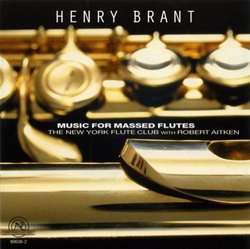Brant's music for flute ensemble is poetic, evocative and fa
Discophage | France | 03/06/2008
(5 out of 5 stars)
"Throughout his compositional life Henry Brant, maybe the last great maverick and experimenters of American music, remained fascinated with what his publisher calls "Ensembles of a Single Tone Quality", which may be aslo described as Homogeneous Timbre ensembles. Besides the present compositions for flute ensemble, there is Orbits for 80 trombones and other pieces for 50 trumpets or 50 guitars. It allowed him for experimentation with timbral color, oftentimes mixed with Brant's most famous visiting card, the spatial dissemination of the instrumental groups in widely separated points of the recording venue. But Brant's music is not just fiddling with timbre and space. It is genuine, evocative, impactful and poetic music.
"Angels and Devils" from 1931, which comes third on this disc, is a seminal piece for Brant, not only in the exploration of rare instrumental combinations and timbral homogeneity, but also to the extent that the composition, thanks to the recording that was made of it, 20 years after its premiere, became Brant's most popular piece, his one "big hit". The liner notes recount the circumstances of both composition and recording. Hearing what must have been one of the first performances of Stravinsky's Symphony of Psalms, the composer was fascinated with its use of five flutes and went to the French flutist George Barrère, then teaching at Juilliard, offering to write a piece for flute ensemble. Barrère was very supportive and arranged several performances in the early thirties. Then, in Brant's own words, "nothing happened for about twenty years". In the early fifties he received an award, in the form of a recording, and this is the piece he chose to record. It is this very recording (originally on CRI) that New World has had the good idea to remaster and publish. Sound is mono, without much spatial bloom, but very clear. Musically it is - surprisingly when you know Brant through his later music but not so surprisingly when you consider the date of composition - gentle, lyrical and playful, with even whimsical dance-like moments smacking of Broadway, and at other moments sweetly contrapuntal passages of almost neo-classical feel, alternating with passages dealing more with pure harmonic color. Already in evidence in some sections is also Brant's flirtation with the Jazz idiom - also a feature of Ghosts and Gargoyles from 2001.
With this recent piece, Brant came back to the flute ensemble, at the imposing age of 88, and seventy years (!) after his first essay in the genre, among other reasons to show the he "wasn't slipping". He wasn't. It is scored for solo flute, flute octet and a Jazz drummer. Only the soloist, conductor and drummer are on stage, the rest of the ensemble being located at the four corners of the hall (much of that is, of course, lost on the stereo recording). Besides the references to Jazz, what remains of his erstwhile style from Angels and Devils is an overall gentleness (other pieces of his I've heard have been more thorny and angular - see my reviews of Kingdom Come/Machinations and V.2 HENRY BRANT COLLECTION), borne no doubt from the very texture of the instrumental ensemble. New aspects include a fascination with and quotations of antiphonal Renaissance church music (also a feature of the disc's third piece, Mass in Gregorian Chant) and particularly Allegri's Miserere, and the use of a full array of novel performing techniques, quarter tone slides, bird-like flatter-tongue effects, multiphonic blowing... But these are all put at the service of a fascinating timbral and, ultimately, poetic invention. Sometimes it sounds like a mysterious, dream-like exotic jungle. Sometimes you get agitated-to-wild solos over slowly-moving harmonic progressions. Sometimes you hear tremors. Sometimes it sounds like a meditative procession. And then comes in the drummer and you get the playful Jazz, with the estrangement effect imparted by the flute ensemble.
The Mass in Gregorian Chant from 1984 seems simple enough in concept: an arrangement for flute ensemble of Gregorian Chant, with material provided by the Graduale Romanum (a book containing the Gregorian chant for the entire liturgical year) for masses sung on June 16. The result of this simple change of timbre is ineffably beautiful, hauntingly atmospheric, mystical, like a dream or a distant memory or simply the decaying resonance in a large Church of religious processions.
Composing for single-timbre ensemble, of course, is nothing new in Western classical music. On the contrary, it has been one of its most trodden genres - but it has been almost exclusively limited to one family: the strings (from duets to string orchestras). In essence, composing for given families of winds or brass should not be very different. In effect and impact, it is. Is it just a matter of the flute ensemble's rarity and the discovery aspect associated with it, or does it have to do with the specific acoustic properties of such ensembles, I do not know. But Brant's music for the ensemble is poetic, evocative and fascinating - and, as mentioned in this review, not aggressive, but very gentle and lulling.
"


 Track Listings (21) - Disc #1
Track Listings (21) - Disc #1